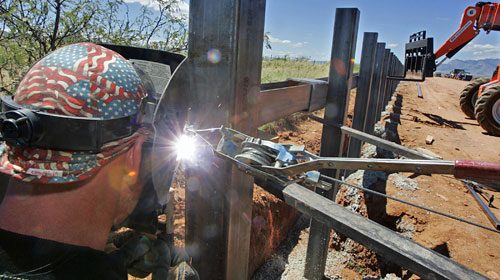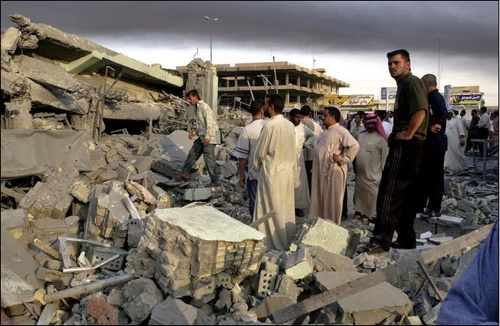Notes
Blinding At The Border

by Bryan Finoki
This image, spotted in a recent LA Times article entitled “Apprehensions of Border-Crossers Drop,” should bring a smile to the face of anyone who believes the border fence has a constructive role to play in the issue of illegal immigration along our southern border.
Photographed in Naco, Arizona, which is just outside of Nogales, the fence installation is the DHS’s attempt to steer the flow of migrants further out toward the Rio Grande desert where geographic conditions are dangerous and public scrutiny is scarce.
This photo of contractors hard at work has all the visual ingredients to convince the viewer this strategy has made considerable progress in slowing border crossers. In the background there’s a clichéd panorama of the formerly open range of the wild west – the classic American landscape in all its glory – while in the foreground, we witness the fervor of heavy work with teams of tractors scoring the landscape in expansive flourishes of tough American steel. The flag on the helmet adds the perfect patriotic stamp to the notion that America can be safeguarded by a ubiquitous external barrier. Whether backed up by hard hat, heavy equipment or poured concrete, the message is the same: barricades are the answer.
A more interesting sign, however, is the blinding flash of light emitted from the welder. What does it mean that the barrier is presented with a light so blinding that, even on a screen, we are forced to look away? Equally – if not more – disturbing is what is being politically shielded by this flash of light.
For example, you probably didn’t hear about that little brouhaha a month or so ago over another group of contractors who were found using China made steel and not the American brand that supporters think should go into the foundation of such a national edifice. And if you caught that story, did you catch the one about the San Diego fencing company which had to pay the government millions in fines for employing illegal immigrants to build another fence installation in Southern California?
Beyond the construction politics, what about the numerous environmental review laws that were waived in order to expedite this project in Southern Arizona? I wonder how many people are aware of the incredible environmental havoc these barriers have – and will continue to reek – on huge lush swaths of Rio Grande real estate, said to be “one of the most biologically diverse places in North America”, or the damage done to the Tijuana estuary, the San Pedro Riparian National Conservation Area, the Buenos Aires National Wildlife Refuge for that matter – all green grist for Chertoff’s security mill. Of course, most could probably care less what a fence might do for the life of the Sonoran Pronghorn, the jaguar, the pygmy owl – an entire border ecology.
But then, how many know that the planned construction will draw a knife across sacred and federally protected Native American land of the Tohono O’odham Nation? Or that south Texan landowners who lie directly in the proposed path and are being warned that their houses may end up in a no man’s land?
And, I would bet almost no one has heard how proposals for added fencing in Texas would see parts of the University of Texas in Brownsville and Texas Southmost College sheared off and shifted to the Mexican side of the border. This information is probably as remote as the roughly 60 border tunnels found in the last decade (ever since the Border Patrol launched Operation Gatekeeper in ‘94), the existence of which literally undermines the logic of a fence.
Through the blinding glare of that welder’s flash, I also wonder how many people have seen other headlines about migrants being detained at record levels or how border crosser deaths have surged despite increased enforcement crackdowns.
For reinforcing the simplistic conclusion that the border fence successfully lowers the number of illegal immigrants who make it into this country on foot across our southern border, the LA Times headline, in combination with this image, is dangerously irresponsible. Fewer apprehensions certainly doesn’t spell fewer successful illegal entrants any more than the border fence equates to a solution to the economic crisis that propels illegal immigration in the first place.
In the end, what the fence most has to offer is a concrete example of how the politics of territory and space have been amended, waived, contested and sidestepped. The DHS not only seeks to triumph over local community wishes and precious federal laws, but over nature itself as the great and free American landscape is transformed into the world’s largest gated community instead.
Bryan Finoki writes about the politics of architecture and the militarization of urban space, and publishes the popular Subtopia blog.
(Image: Don Bartletti/Los Angeles Times. 2007. Arizona)


Reactions
Comments Powered by Disqus